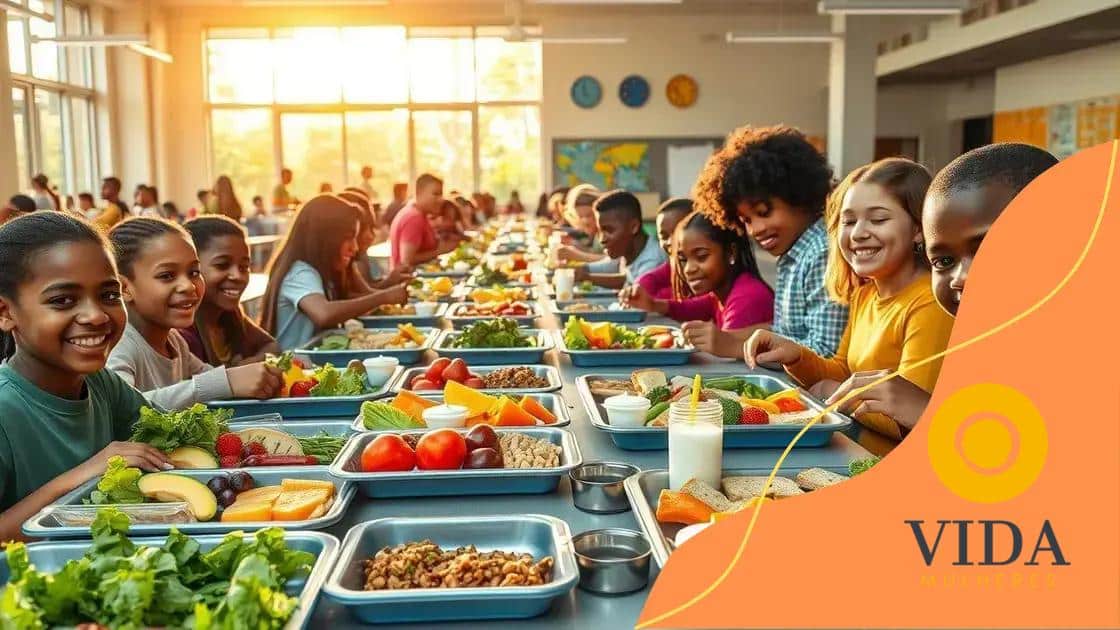School lunch reform takes center stage in health debate

School lunch reform takes center stage in health debate by prioritizing nutritious meals, engaging communities, leveraging technology, and implementing innovative programs to enhance student health and academic performance.
School lunch reform takes center stage in health debate today, highlighting how essential nutritious meals are for our students. Are we doing enough to provide them with what they need?
The current state of school lunches
The current state of school lunches is a crucial topic that affects many children and their health. Many schools are working hard to improve the quality of food served, but there are still challenges. We need to look at what is being served and how it affects students.
Nutritional Standards
In recent years, the government has set higher nutritional standards for school lunches. These standards aim to provide more fruits, vegetables, whole grains, and lean proteins. This has resulted in many schools offering healthier meals.
Challenges Faced
Despite these improvements, schools still face significant challenges. Some include:
- Limited funding for purchasing fresh foods.
- Resistance to change among students.
- Supply chain issues that can affect food availability.
Additionally, the variety of food can sometimes be limited, leading students to choose less healthy options. Schools are experimenting with new recipes and learning what their students enjoy, aiming to make healthy eating appealing.
Student Participation
One important aspect of improving school lunches is involving students in the process. When students help select meals or develop new ideas, they are more likely to eat the healthy options offered. This participation is key in ensuring school lunch reform works well.
Overall, while progress is being made, there is still much work to be done to ensure that every student has access to healthy, nutritious meals each day. Continuing to push for school lunch reform is essential as we work toward a healthier future for our children.
Key players in the reform movement

The key players in the reform movement for school lunches include various stakeholders working together to improve the quality of food served to students. These individuals and organizations play a vital role in shaping policies and promoting healthier options in schools.
Government Agencies
Government bodies, such as the USDA, set regulatory standards for school meals. Their guidelines are crucial in ensuring that schools provide nutritious food. These agencies also provide funding and resources to help schools meet these standards.
Nonprofit Organizations
Nonprofits like Share Our Strength and Action for Healthy Kids advocate for better nutrition policies, focusing on food access and health education. They work to bring awareness to the importance of healthy meals and support schools with programs that encourage changes.
School District Leaders
School district leaders, including superintendents and nutrition directors, are at the forefront of implementing these changes. They have the responsibility of designing menus, managing budgets, and finding vendors who can supply quality food.
Teachers and parents are also important players in this movement. Teachers can educate students about healthy eating, while parents can support initiatives that promote better school lunches. Parent-teacher associations (PTAs) often help in fundraising efforts to provide nutritious alternatives.
Students, the most affected party, have a voice in this process too. Their feedback on meals can influence menu planning. Engaging students in discussions about food choices can lead to better participation in healthy eating practices.
All these key players must collaborate to ensure that the school lunch reform movement is successful. Communication and teamwork can lead to lasting changes in how our children eat at school, which ultimately benefits their overall health and academic performance.
Impact on student health and performance
The impact on student health and performance due to school lunches is significant. Healthy meals can positively influence the overall growth and development of children. When students eat well, their bodies and minds function better, which is critical for academic success.
Physical Health Benefits
Nutrition plays a key role in a child’s physical health. When schools provide balanced meals, students are less likely to suffer from obesity and related health issues. Some major benefits include:
- Improved immune function.
- Increased energy levels.
- Better dental health.
- Lower risk of chronic diseases.
By ensuring that students have access to nutritious food, schools can help them develop healthier habits that last a lifetime.
Academic Performance
Studies show a direct link between nutrition and academic performance. When students consume meals rich in fruits, vegetables, and whole grains, they are more likely to concentrate in class and perform better on tests. Proper nutrition also supports cognitive functions, such as:
- Memory retention.
- Attention span.
- Problem-solving skills.
This means that a well-balanced lunch can lead to better grades and overall learning outcomes. Additionally, when students enjoy their meals, they are more likely to participate in school meal programs, reducing waste and ensuring that resources are utilized effectively.
Furthermore, the impact on student health extends beyond the classroom. Healthy eating can lead to improved mental health, reducing feelings of anxiety and depression, which are increasingly common among students. Therefore, school lunch reform is not just about food; it’s about creating a nurturing environment where students can thrive in all aspects of their lives.
Innovative programs and solutions
Innovative programs and solutions are vital for improving school lunches and ensuring students receive nutritious meals. Many schools are adopting creative strategies to enhance the quality and appeal of their lunch offerings.
Farm-to-School Programs
One popular approach is the farm-to-school program. This initiative connects schools with local farms. By sourcing fresh produce from nearby farms, schools can provide students with healthy, seasonal foods. These programs not only improve lunch quality but also support local economies and teach students about healthy eating.
Nutrition Education
Integrating nutrition education into the curriculum is another effective strategy. Schools are fostering an understanding of healthy eating by teaching students where their food comes from and how it affects their health. This education can motivate students to choose healthier options during lunch.
- Workshops and cooking classes.
- Field trips to local farms.
- Engaging students in meal planning.
These hands-on experiences make learning about nutrition fun and practical.
Menu Innovations
Schools are experimenting with menu innovations to keep meals exciting. Creative food presentations and diverse meal options can entice students to try new foods. Some schools have introduced:
- Theme days for various cuisines.
- Wrappers and bowls instead of traditional plates.
- Vegetable-based pizzas and burgers.
These changes can make lunchtime more appealing and promote the consumption of healthy foods.
Partnerships with chefs and local restaurants also help schools develop unique recipes that align with nutrition guidelines. Overall, these innovative solutions are essential for advancing the school lunch reform movement, leading to healthier eating habits among students.
Future of school lunch policies
The future of school lunch policies is an important topic as more schools strive to meet the nutritional needs of students. With ongoing discussions and reforms, it is clear that these policies will continue to evolve. Many stakeholders are considering how to make improvements that benefit everyone involved.
Increasing Focus on Health
As awareness increases about the relationship between diet and health, school lunch policies are changing. There is a growing emphasis on providing not just meals, but nutritious meals that promote student well-being. Advocacy groups are pushing for better standards and options for students, helping to shape policies that prioritize health.
Incorporating Technology
Technology is also playing a significant role in the future of school lunches. Schools are beginning to use software to track food inventory and menu planning. This can help in maintaining a balance between options and waste. Additionally, online platforms may allow parents to see what their children are eating and give feedback.
- Smart nutrition apps for healthy choices.
- Online ordering systems for students.
- Data tracking to optimize meal planning.
With the help of technology, schools can not only enhance meal offerings but also engage families in the process.
Community and Parental Involvement
Community support plays a critical role in the success of school lunch reforms. Schools are encouraged to involve parents and local organizations in decision-making. This collaboration can lead to better food sourcing and meal options. When schools work closely with their communities, they can create policies that celebrate local food traditions while ensuring nutritional quality.
The future looks promising, with new strategies and partnerships forming. Continued advocacy and innovation ensure that the school lunch policies will continue to improve, benefiting the health and education of all students.
FAQ – Frequently Asked Questions about School Lunch Reform
What is the goal of school lunch reform?
The goal of school lunch reform is to provide healthier meal options for students, ensuring their nutritional needs are met and enhancing their overall health and academic performance.
How can parents get involved in school lunch programs?
Parents can get involved by participating in school meetings, providing feedback on food options, and volunteering with local farms or cooking classes that promote healthy eating.
What role does technology play in modern school lunch policies?
Technology helps in tracking food inventory, planning menus, and engaging families by keeping them informed about meal options and nutrition.
How do farm-to-school programs benefit schools and students?
Farm-to-school programs provide fresh, local produce to schools, improving meal quality and teaching students about the importance of healthy eating and supporting local agriculture.






